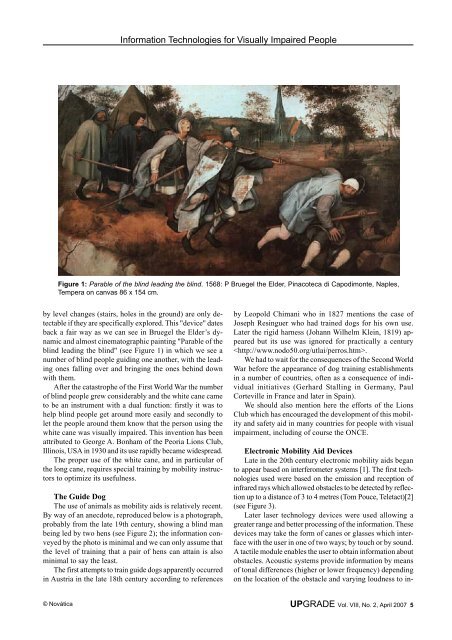Download full issue (PDF 2.1MB) - Council of European ...
Download full issue (PDF 2.1MB) - Council of European ...
Download full issue (PDF 2.1MB) - Council of European ...
Create successful ePaper yourself
Turn your PDF publications into a flip-book with our unique Google optimized e-Paper software.
© Novática<br />
Information Technologies for Visually Impaired People<br />
Figure 1: Parable <strong>of</strong> the blind leading the blind. 1568: P Bruegel the Elder, Pinacoteca di Capodimonte, Naples,<br />
Tempera on canvas 86 x 154 cm.<br />
by level changes (stairs, holes in the ground) are only detectable<br />
if they are specifically explored. This "device" dates<br />
back a fair way as we can see in Bruegel the Elder’s dynamic<br />
and almost cinematographic painting "Parable <strong>of</strong> the<br />
blind leading the blind" (see Figure 1) in which we see a<br />
number <strong>of</strong> blind people guiding one another, with the leading<br />
ones falling over and bringing the ones behind down<br />
with them.<br />
After the catastrophe <strong>of</strong> the First World War the number<br />
<strong>of</strong> blind people grew considerably and the white cane came<br />
to be an instrument with a dual function: firstly it was to<br />
help blind people get around more easily and secondly to<br />
let the people around them know that the person using the<br />
white cane was visually impaired. This invention has been<br />
attributed to George A. Bonham <strong>of</strong> the Peoria Lions Club,<br />
Illinois, USA in 1930 and its use rapidly became widespread.<br />
The proper use <strong>of</strong> the white cane, and in particular <strong>of</strong><br />
the long cane, requires special training by mobility instructors<br />
to optimize its usefulness.<br />
The Guide Dog<br />
The use <strong>of</strong> animals as mobility aids is relatively recent.<br />
By way <strong>of</strong> an anecdote, reproduced below is a photograph,<br />
probably from the late 19th century, showing a blind man<br />
being led by two hens (see Figure 2); the information conveyed<br />
by the photo is minimal and we can only assume that<br />
the level <strong>of</strong> training that a pair <strong>of</strong> hens can attain is also<br />
minimal to say the least.<br />
The first attempts to train guide dogs apparently occurred<br />
in Austria in the late 18th century according to references<br />
by Leopold Chimani who in 1827 mentions the case <strong>of</strong><br />
Joseph Resinguer who had trained dogs for his own use.<br />
Later the rigid harness (Johann Wilhelm Klein, 1819) appeared<br />
but its use was ignored for practically a century<br />
.<br />
We had to wait for the consequences <strong>of</strong> the Second World<br />
War before the appearance <strong>of</strong> dog training establishments<br />
in a number <strong>of</strong> countries, <strong>of</strong>ten as a consequence <strong>of</strong> individual<br />
initiatives (Gerhard Stalling in Germany, Paul<br />
Corteville in France and later in Spain).<br />
We should also mention here the efforts <strong>of</strong> the Lions<br />
Club which has encouraged the development <strong>of</strong> this mobility<br />
and safety aid in many countries for people with visual<br />
impairment, including <strong>of</strong> course the ONCE.<br />
Electronic Mobility Aid Devices<br />
Late in the 20th century electronic mobility aids began<br />
to appear based on interferometer systems [1]. The first technologies<br />
used were based on the emission and reception <strong>of</strong><br />
infrared rays which allowed obstacles to be detected by reflection<br />
up to a distance <strong>of</strong> 3 to 4 metres (Tom Pouce, Teletact)[2]<br />
(see Figure 3).<br />
Later laser technology devices were used allowing a<br />
greater range and better processing <strong>of</strong> the information. These<br />
devices may take the form <strong>of</strong> canes or glasses which interface<br />
with the user in one <strong>of</strong> two ways; by touch or by sound.<br />
A tactile module enables the user to obtain information about<br />
obstacles. Acoustic systems provide information by means<br />
<strong>of</strong> tonal differences (higher or lower frequency) depending<br />
on the location <strong>of</strong> the obstacle and varying loudness to in-<br />
UPGRADE Vol. VIII, No. 2, April 2007 5


